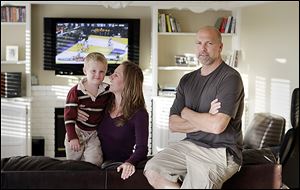
Lenders venturing back into subprime
Americans eager to rebuild finances
5/19/2013
Because of a past foreclosure, Michele and Russell Poland turned to a subprime mortgage to buy their current home in Temecula, Calif. ‘It was expensive, but we think it’s worth it,’ Mr. Poland said.
LOS ANGELES — Michele and Russell Poland’s credit was shot, but they managed to buy their suburban dream home anyway.
After a business bankruptcy and a home foreclosure, they turned to a rare option in this era of tightfisted banking — a subprime loan.
The Polands paid nearly $10,000 in upfront fees for the privilege of securing a mortgage at 10.9 percent interest. And they had to raid their retirement account for a 35 percent down payment.
Most borrowers would balk at such stiff terms. But with prices rising, the Polands wanted to snag a four-bedroom home in Temecula, Calif., near top-rated schools for their 5-year-old son.
By later this year, they figure, they’ll be able to refinance into a standard loan.
“The mortgage is a bridge loan,” said Mr. Poland, an insurance investigator. “It was expensive, but we think it’s worth it.”
In the aftermath of the housing crash, there’s no shortage of Americans who, like the Polands, are eager to rebuild their shattered finances.
In response, lenders are emerging to offer the classic subprime trade-off: high-priced loans for high-risk customers.
Before the housing bust, a sprawling business arose in subprime mortgages and their cousins, so-called alt-A loans, which were issued to people who had decent credit but did not have to prove income. About $1 trillion in subprime and alt-A loans were originated in 2005 and again in 2006 — more than a third of all home loans, according to the trade publication Inside Mortgage Finance.
But the explosion of mortgage defaults that began in late 2006 vaporized an entire industry of subprime specialists. The Wall Street firms that had bundled the loans into securities soon began to implode as well. Little wonder that loans for the credit-challenged disappeared.
Today’s high-risk lenders differ from those during the housing boom in key ways. These lenders say the new subprime mortgages are actually old-school — the kind of loans made in the 1980s and 1990s. In other words, a borrower’s collateral matters, down payments matter, and income and ability to pay matter.
Subprime lenders care because they are holding the loans on their books rather than selling them to investors. They hope a private securities market for subprime loans, also destroyed in the meltdown, will re-emerge soon.
For now, the subprime and alt-A business remains small, maybe $8 billion total, estimated Inside Mortgage Finance Editor Guy D. Cecala. That’s less than half of 1 percent of the $1.8 trillion in U.S. home loans last year.
Among those hoping to reverse the trend is the Polands’ lender, Citadel Servicing Corp. of Orange County, California. Chief Executive Daniel L. Perl said he has tested the water by making a few dozen subprime loans since late 2011, mostly with his own money rather than investment capital.
The Polands, among the first to receive Citadel loans, are part of a success story, Mr. Perl said.
None of the loans has gone bad; about a third have already been paid off. With that track record, Mr. Perl recently raised $200 million from private investors. He’s hiring 55 employees to help him make loans through mortgage brokers across most of the West, and he’s moving to larger offices.
“We’re looking to build it up over the next 24 months to $30 million to $50 million a month,” Mr. Perl said. “It’s a decent business plan in a credit-barren world.”
But lenders such as Mr. Perl are proceeding far more carefully than during the housing bubble. Then, borrowers commonly avoided down payments entirely in “piggyback” arrangements that allowed one loan of 80 percent, another for 20 percent. Some lenders offered “Ninja” loans — requiring no proof of income, assets, or even a job.
Mr. Perl now requires 25 percent to 40 percent down, depending on credit scores that can drop as low as 500 on an 850-point scale. Potential customers, who pay a minimum of 7.95 percent interest, include higher-income as well as lower-income borrowers.
“Quite a few” affluent borrowers are good credit risks, Mr. Perl said, even though they had recent short sale; they sold homes for less than they owed on their mortgages. Mr. Perl also writes mortgages that exceed the Fannie Mae and Freddie Mac threshold for conventional loans, which varies but tops out at $625,500 in the most expensive areas.
“They come from all walks of life, doctors and lawyers as well as blue-collar workers,” Mr. Perl said. “As long as they have the ability to pay and equity in their homes, they are a candidate for one of our loans.”